Wireless Power Transfer Systems for Roadway-powered Electric Vehicles
Chun T. Rim, Senior Member, IEEE (ctrim@kaist.ac.kr)
Recent developments of electric vehicle technologies have largely been driven by requirements to reduce emissions of greenhouse gases (GHG) such as CO2 and to mitigate air pollution especially in urban areas. Various electric vehicles use batteries for energy storage therefore heavily reply on the available battery products and their technology development. Hybrid electric vehicles (HEV) are also gaining popularity due to the limited use of the battery for short term energy recovery.
In contrast, roadway powered electric vehicles (RPEV) among other electric vehicles do not necessarily require battery energy storage for their traction as they are using dynamic wireless power transfer systems (WPTS) to get the power as they are moving on roads. This is seen as a promising candidate for future propulsion of small cars, taxies, buses, trams, trucks and trains. It can even be competitive with internal combustion engine powered vehicles.
Various WPTS have been developed for RPEV. Among them, one noteworthy technology is the inductive power transfer systems (IPTS). Various IPTS systems have been proposed for stationary or static and dynamic charging of electric vehicles wirelessly since 1990s including those developed by Auckland University [16-20] in which a circular or rectangular type coil is used as the primary coil with various secondary coils (such as circular types or double sided types and single-sided polarised coils with an additional coil for enhanced performance for high power transfer). Circular coils have the merits of a compact structure, lower weight and lower electromagnetic field (EMF) but can be limited by power transfer capacity and less lateral tolerance. Instead, rectangular core plates have potentially higher coupling factors and large lateral tolerances. Due to the adoption of many smaller power pads (see Fig.1 below), to avoid unwanted energising and loading, these systems have a higher deployment and maintenance cost for the ground power pads and control complexity.
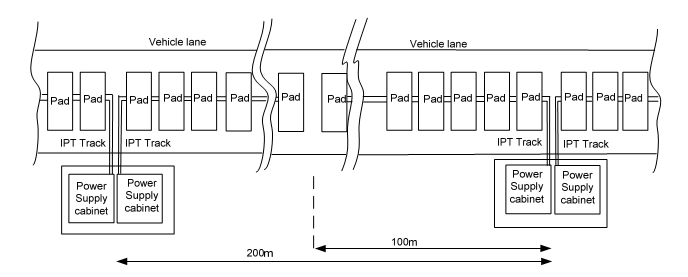 |
| Figure 1: The configuration of an IPTS using many small power pads by Auckland team (18). |
Bombardier has developed several IPTS systems [21]-[28] for stationary and dynamic charging of trams and buses since 2010, as shown in Fig. 2. With the PRIMOVE project applying IPTS technologies to transportation sectors, the Bombardier used an operating frequency of 20 kHz and a three phase power system for their IPTS to obtain a higher power density without exceeding the EMF guidelines. For the stationary and dynamic charging, a power transfer of ~250 kW for PRIMOV trams has been achieved in Augsburg, Germany (at a minimal coupling distance).
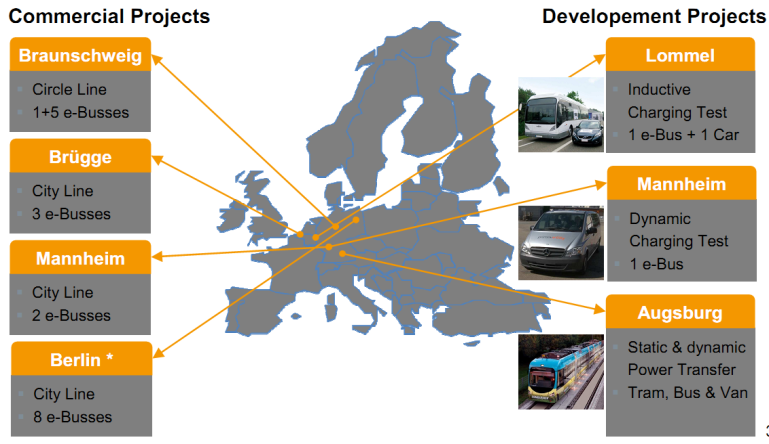 |
| Figure 2: The commercialization and development projects for RPEV by the Bombardier team (25). |
The Oak Ridge National Laboratory (ORNL) has been investigating the IPTS for RPEV since 2011 [27-28] ORNL used many circular coils as power supply coils and pick-up coils with an aim to reduce the construction cost. The ORNL also used operating frequencies around 20 kHz and achieved the maximum power transfer of 2.2 kW with an efficiency of 74%, which was limited by the 72 V lead acid battery on the GEM vehicle.
Recently, significant progress has been made in the developments of the on-line electric vehicles (OLEV) based on the various IPTS technologies by KAIST, Korea. Figure. 3 below shows the OLEV bus concepts.
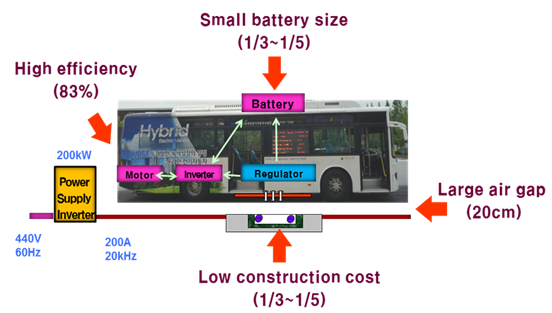 |
| Figure 3: Development concepts of the OLEV bus by KAIST (11). |
Since 2009, KAIST has developed and tested a few generations of OLEV as shown in Fig. 4 ranging from the first generation (1G) concept-demonstration-car of OLEV, the second generation (2G) OLEV buses, the third generation (3G) OLEV passenger car and the fourth generation (4G) OLEV bus which showed improved performance with a very narrow rail width of 10 cm, a larger lateral displacement of 40 cm, lower EMF level, and lower power rail construction cost.
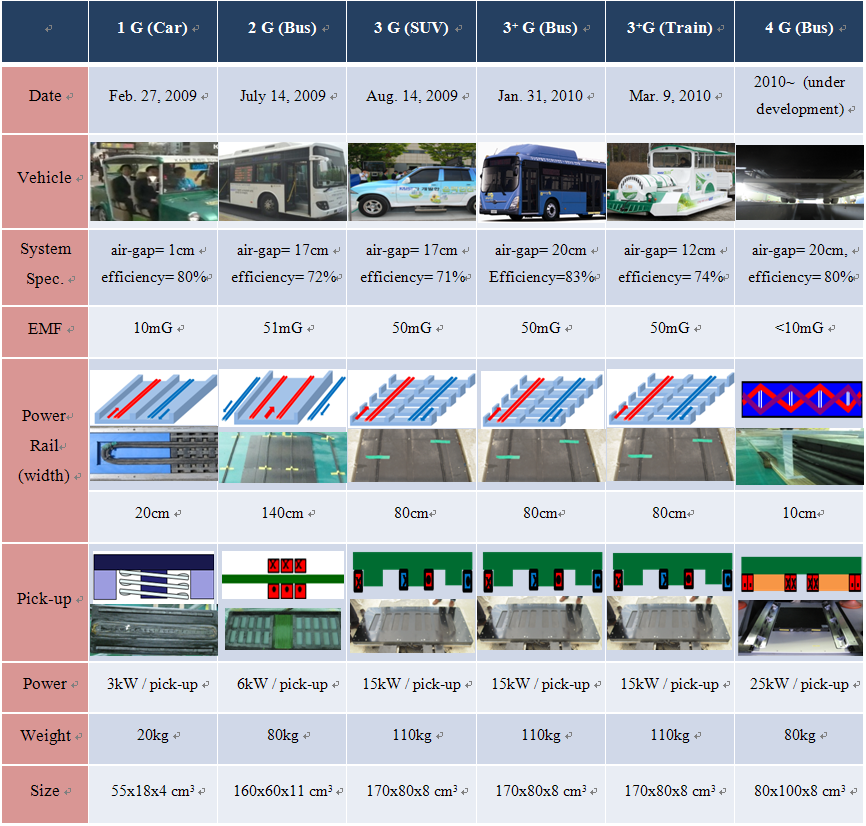 |
| Figure 4: Summary of the OLEV developments with IPTS (11). |
The fifth generation (5G) OLEV is now in progress. The 5G OLEV has an ultra slim S-type core when viewed from the front as shown in Fig. 5 (a). The width of the S-type power supply module is significantly reduced compared to the I-type width of 10 cm, as shown in Fig. 5(b). The S-type core makes it easier to fold, has a minimal impact to the existing road surface for deployment and there is no need for power cable connection after deployment.
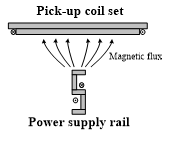 |
| Figure 5: Proposed ultra-slim S-type power rail and the flat pick-up coil of the IPTS (13)-Front View |
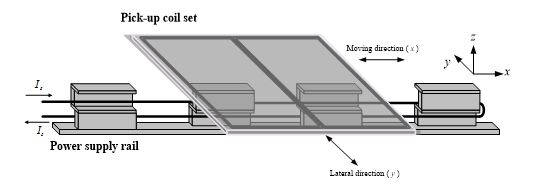 |
| Figure 5 (b): Proposed ultra-slim S-type power rail and the flat pick-up of the IPTS (13)- birds view |
Since the first introduction of the IPTS in RPEV its performance has been substantially improved in terms of the size, weight, efficiency, air-gap, lateral tolerance, EMF and cost. The IPTS based RPEVs are becoming viable solutions for future transportations, especially the firstly commercialised OLEVs are showing promise for the widespread use of the RPEV in electrified public transportation.
References
- J. G. Bolger and F. A. Kirsten, Investigation of the feasibility of a dual mode electric transportation system, Lawrence Berkeley Laboratory Report, LBL6301, May 1977.
- Santa Barbara Electric Bus Project, Phase 3A-final report, Santa Barbara Research Paper, Sept. 1983.
- KAIST OLEV team, Feasibility studies of On-Line Electric Vehicle (OLEV) Project, KAIST Internal Report, Aug. 2009.
- N. P. Suh, D. H. Cho, and Chun T. Rim, “Design of on-line electric vehicle (OLEV),” Plenary lecture at the 2010 CIRP Design Conference, 2010, pp. 3-8.
- S. W. Lee, J. Huh, C. B. Park, N. S. Choi, G. H. Cho, and Chun T. Rim, “On-line electric vehicle (OLEV) using inductive power transfer system,” IEEE Energy Conversion Congress and Exposition (ECCE), 2010, pp. 1598-1601.
- J. Huh, S. W. Lee, C. B. Park, G. H. Cho, and Chun T. Rim, “High performance inductive power transfer system with narrow rail width for on-line electric vehicles,” IEEE Energy Conversion Congress and Exposition (ECCE), 2010, pp. 647-651.
- S. W. Lee, C. B. Park, J. G. Cho, G. H. Cho, and Chun T. Rim, “Ultra slim U & W power supply and pick-up coil design for OLEV,” Korean Institute of Power Electronics (KIPE) Annual Summer Conference, 2010, pp. 353-354.
- J. Huh and Chun T. Rim, “KAIST wireless electric vehicles – OLEV,” JSAE Annual Congress, 2011.
- J. Huh, W. Y. Lee, G. H. Cho, B. H. Lee, and Chun T. Rim, “Characterization of novel inductive power transfer systems for on-line electric vehicles (OLEV),” IEEE Applied Power Electronics Conference & Exposition (APEC), 2011, pp. 1975-1979.
- J. Huh, S. W. Lee, W. Y. Lee, G. H. Cho, and Chun T. Rim, “Narrow-width inductive power transfer system for on-line electrical vehicles (OLEV),” IEEE Trans. on Power Electron., Vol. 26, No. 12, pp. 3666-3679, Dec. 2011.
- Chun T. Rim, “The development and deployment of on-line electric vehicles (OLEV),” IEEE Energy Conversion Congress and Exposition (ECCE), 2013.
- Su Y. Choi, J. Huh, W. Y. Lee, S. W. Lee, and Chun T. Rim, “New cross-segmented power supply rails for roadway powered electric vehicles,” IEEE Trans. on Power Electron, Vol. 28, no. 12, pp. 5832-5841, Dec. 2013.
- Su Y. Choi, Beom W. Gu, Seog Y. Jeong, and Chun T. Rim, “Ultra-slim S-type inductive power transfer system for roadway powered electric vehicles,” International Electric Vehicle Technology Conference & Automotive Power Electronics in Japan (EVTeC & APE Japan),Accepted for Publication.
- M. Budhia, G. A. Covic, and J. T. Boys, “Design and optimization of magnetic structures for lumped inductive power transfer systems,” IEEE Trans. on Power Electron., vol. 26, no. 11, pp. 3096–3108, Nov. 2011.
- M. Budhia, G. A. Covic, and J. T. Boys, “A new magnetic coupler for inductive power transfer electric vehicle charging systems,” in Proc. 36th Annu. Conf. IEEE Ind. Electron., Nov. 2010, pp. 2487–2492.
- M. Budhia, J. T. Boys, G. A. Covic, and C.-Y. Huang, “Development of a single-sided flux magnetic coupler for electric vehicle IPT charging systems,” IEEE Trans. on Ind. Electron., vol. 60, no. 1, pp. 318–328, Jan. 2013.
- G. A. Covic, J. T. Boys, M. Kissin, and H. Lu, “A three-phase inductive power transfer system for roadway power vehicles,” IEEE Trans. Ind. Electron., vol. 54, no. 6, pp. 3370–3378, Dec. 2007.
- G. A. Covic and J. T. Boys, “Modern trends in inductive power transfer for transportation applications,” IEEE Journal of Emerging and Selected topics in power electronics, vol. 1, no. 1, pp. 28-41, Mar. 2013.
- J. Meins and S. Carsten, “Transferring energy to a vehicle,” Patent WO 2010 000494, 2010.
- J. Meins and K. Vollenwyder, “System and method for transferring electrical energy to a vehicle,” Patent WO 2010 000495, 2010.
- K. Vollenwyder, J. Meins, and C. Struve, “Inductively receiving electric energy for a vehicle,” Patent US 0055751, 2012.
- M. Zengerle, “Transferring electric energy to a vehicle using a system which comprises consecutive segments for energy transfer,” Patent US 0217112, 2012.
- K. Vollenwyder and J. Meins, “Producing electromagnetic fields for transferring electric energy to a vehicle,” Patent US 8544622, 2013.
- R. Czainski, J. Meins, and J. Whaley, “Transferring electric energy to a vehicle by induction,” Patent US 0248311, 2013.
- J. Meins, “German activities on contactless inductive power transfer,” IEEE Energy Conversion Congress and Exposition (ECCE), 2013.
- Bombardier PRIMOVE Website, “http://primove.bombardier.com/media/news/”.
- Omer C. Onar, John M. Miller, Steven L. Campbell, Chester Coomer, Cliff. P. White, and Larry E. Seiber, “A novel wireless power transfer for in-motion EV/PHEV charging,” IEEE Applied Power Electronics Conference & Exposition (APEC), 2013, pp. 3073-3080.
- John M. Miller, Omer C. Onar, and P. T. Jones, “ORNL developments in stationary and dynamic wireless charging,” IEEE Energy Conversion Congress and Exposition (ECCE), 2013.
About the Newsletter
Editors-in-Chief

Jin-Woo Ahn
Co-Editor-in-Chief

Sheldon Williamson
Co-Editor-in-Chief
TEC Call for Articles 2023 - Advances in Charging Systems
The TEC eNewsletter is now being indexed by Google Scholar and peer-reviewed articles are being submitted to IEEE Xplore.
To submit an article click here.


